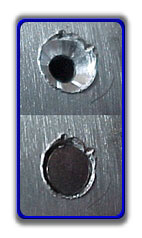2001 Kawasaki Lakota Sport Hop-up Series
| Lakota Sport Modifications, Part 4 SuperTrapp IDS2 (Quiet) |
 |
 The removal of the factory system was straight forward. Remove the heat guard as shown and install on the SuperTrapp pipe. We found the weight of the factory system to be 10lbs, with the SuperTrapp coming in at 4lbs for a net loss of 6lbs. However when you factor in the factory muffler can heat shield and mounting bolts that are not used with the SuperTrapp, we picked up another pound for a net loss of 7lbs. That is headed in the right direction for an over weight machine.
The removal of the factory system was straight forward. Remove the heat guard as shown and install on the SuperTrapp pipe. We found the weight of the factory system to be 10lbs, with the SuperTrapp coming in at 4lbs for a net loss of 6lbs. However when you factor in the factory muffler can heat shield and mounting bolts that are not used with the SuperTrapp, we picked up another pound for a net loss of 7lbs. That is headed in the right direction for an over weight machine.| Installation of the SuperTrapp was straight forward. Do not forget to install the muffler can retaining rivet. The upper frame shows the bevel and the lower shows the retaining rivet installed, flush with the muffler can surface. With all the mounting bolts and nuts in place, start the tightening process at the headpipe and work backward. |  |
| Next we went about assembling the spark arrestor and end cap. From left to right and top to bottom: Extra discs we didn’t use, closed end cap and our stack of 8 discs, anti-seize lubricant, T-handle for installation of the disc bolts, end cap retaining screws & lockwashers, Allen wrench for those screws, short and long disc installation bolts and the aluminum end cap. |  |
| Looking down inside the aluminum can muffler you can see the mechanical muffler that is used in the Quiet IDS2 to control noise. |  |
| Next coat the appropriate length disc mounting bolts (we used the shorter bolts due to using 8 discs) with the Saf-t-eze lubricant as shown. |  |
| With the discs and closed cap in place, this is what you should see. |  |
| Install the aluminum end cap and install the mounting screws and lockwashers. |  |
| With the system completely installed and all mounting bolts tightened, it looks quite racy. Just hope it works! |  |
| According to the instructions included with the K&N Power Kit we needed to raise the main jet from a #134 to a #138. Since we had previously removed the float bowl to install the Power Kit, it was quite easy to remove the float bowl with the carb in place using a Snap-On #2 impact bit (because we didn’t over tighten the bowl screws upon reassembly!) and replace the main jet using our custom idle mixture screwdriver (cut down screwdriver) |  |
On a 95°F day, we found the main jet to be slightly rich, producing a stumble once in a while if over reved in the lower gears. Throttle response was increased again (It’s getting quite snappy compared to stock!) and we had to open up the idle mixture another full turn to eliminate a deceleration backfire. Acceleration was much stronger through the gears. We retested on a slightly cooler day (86°F) and were rewarded with a new GPS top speed of 56.1 mph. This is an increase of 1.6 mph or 3%.
Even at 86°F, the jetting is still a little fat. I think the jetting should be dropped back to a #136 and it should run a little cleaner on top. Note: that would be for our 8 discs and 400ft altitude. Your jetting may be different.) Now the bad news, there is NO #136 Mikuni main jet size, nor aftermarket either! Soooo, you will need to order a Yamaha snowmobile main jet #136.3 P/n 3G2-1423E-54-00. Unusual, but the only way to go for spot on jetting for our conditions. (86°F @+400ft.) After the main jet change we noticed that the midrange was slightly fat with the SuperTrapp pipe so the carb came back off again and the clip was raised another notch (now 2nd from top) and this cleaned the midrange.
We were pleasantly surprised by the exhaust tone. While noticably deeper than stock, it was still subdued and never became sharp, even when rapping on it. This pipe should not be objectionable to others behind you on the trail. And judging by the performance gain, sound does NOT equal power. We are happy for that!
(mph and percentage gains were rounded to 1 decimal point)
| Work Performed | GPS Recorded Speed | Performance Gain | Total Gain |
| Stock | 51.3 mph | ||
| K&N Power Kit | 53.1 mph | +1.8 mph or +3.5% | 3.5% |
| Sunstar +1 Countershaft Sprocket | 54.5 mph | +1.4 mph or +2.6% | 6.2% |
| SuperTrapp IDS2 Quiet Series | 56.1 mph | +1.6 mph or +3% | 9.3% |
So what did we learn? The Lakota Sport is jetted way fat from the factory. And it responds well to taller gearing. And if allowed to breath with a free flowing exhaust (even a restricted quiet model like the IDS2 Quiet) it responds quite well. There is little the same in the way the stock Lakota Sport and the ATV Connection modified Sport responds to throttle and accelerates. The stocker wouldn’ t stand a chance! And we have not made any concessions to it’ s trail manners. It still is great in the woods, now just more so.
Part 5 will cover the installation of the new Titan 489X/T tires in the rear and some much needed weight reduction.
